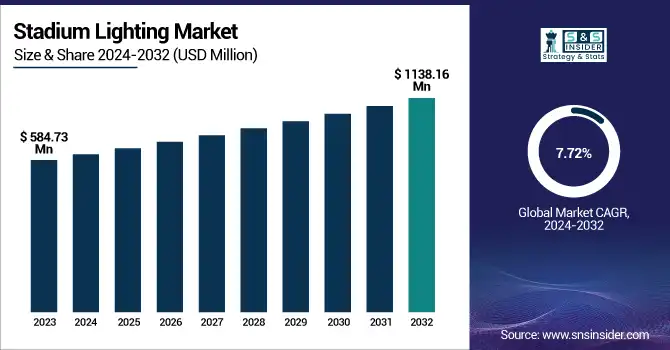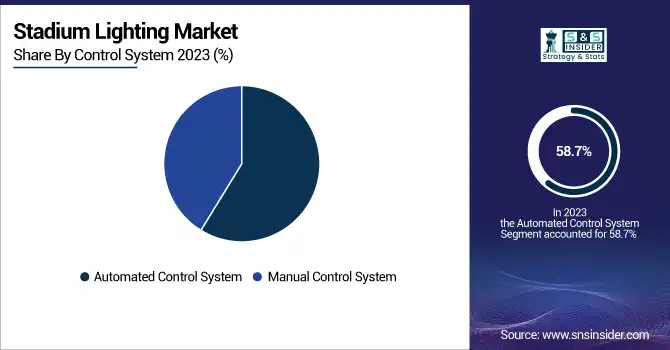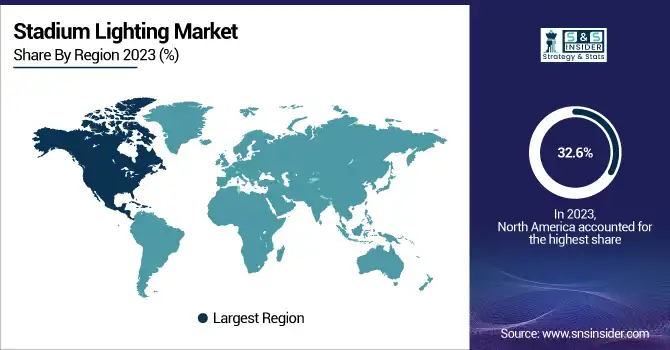Stadium Lighting Market Size & Growth:
The Stadium Lighting Market was valued at USD 584.73 million in 2023 and is expected to reach USD 1138.16 million by 2032, growing at a CAGR of 7.72% over the forecast period 2024-2032. With the increasing penetration of innovative lighting solutions, the stadium lighting industry is changing to adopt automation and connectivity through IoT technology. Power consumption patterns are changing from the classic HID lights to modern LED systems, with 50% energy reduction.

To Get more information on Stadium Lighting Market - Request Free Sample Report
Modern stadiums have rigid illumination standards with high-lux levels applicable to professional sports and broadcasting. Also, sustainability is applied through lowering CO₂ footprints and integrating renewables for green stadiums. U.S. stadium lighting is beginning to transition to LED systems at a rapid pace and will begin to grow in the future due to the increased energy efficiency with LEDs as well as superior lighting. University of Phoenix Stadium and U.S. Bank Stadium (MN) features many of these advances in LED lighting for spectator comfort and more at a lower operating cost. Being situated in the U.S. they have around 244 stadiums, indicating extensive investment and renovation of the sports infrastructures.
U.S. Stadium Lighting Market size was valued at USD 149.32 Million in 2023 and the total Stadium Lighting revenue is expected to grow at a CAGR of 7.56% from 2024 to 2032. the U.S. stadium lighting market is driven by an increase in the number of sports events, government incentives for energy-efficient upgrades, and developments in wireless lighting control systems. Furthermore, the rise in multi-purpose stadiums, integration of AR for fan engagement, and dynamic lighting effects for concerts and events are driving the market growth.
Stadium Lighting Market Dynamics
Key Drivers:
-
Revolutionizing Stadium Lighting with Smart Technology Energy Efficiency and Global Sports Event Demand
The key factor driving the growth of the stadium lighting market is the growing utilization of energy-preserving LED lighting due to its high illumination, lower power consumption, and greater lifespan compared to conventional lighting systems. Globally, due to smart stadium projects governments and sports organizations are investing in advanced smart lighting solutions, which are integrated with IoT and automation solutions for better performance and energy-efficient smart stadiums. Moreover, increasing sports events, for example, the FIFA World Cup, Olympics, and IPL are driving higher demand for stadium lighting with exceptional quality. Market growth is further propelled due to technological advancements like wireless control systems, adaptive lighting, and consumer electronics control based on high-definition broadcast output compatibility. The size of the market in North America has the largest market share owing to huge investments in sports infrastructure, whereas Asia Pacific is expected to be the fastest-growing region for the market due to the rise in sports events and urbanization.
Restrain:
-
Overcoming Installation Challenges in Stadium Lighting with Smart Technology Skilled Workforce and Compliance
The complexity of installation and maintenance is one of the key challenges of the stadium lighting market. Modern stadium lighting systems consist of high-precision setups with high-intensity illumination, glare control, and either unrestricted or restricted uniform light distribution to meet broadcasting standards. A skilled labor force and infrastructure will be required to integrate smart lighting technologies, IoT-enabled controls, and wireless systems, which can take time to implement. The need for regulatory compliance with sports federations and environmental standards increases the complexity with which appropriate lighting solutions must be produced. Such variables cause technical issues with modifying old stadiums, particularly in areas with legacy infrastructure.
Opportunity:
-
AI-Powered Smart Lighting and Multi-Purpose Stadiums Driving Innovation and Sustainability in Stadium Lighting
Market prospects are associated with the combination of artificial intelligence intelligent lighting solutions with automatic control systems that dynamically change the brightness and power depending on real-time needs. First, the growing construction of multi-perform sports stadiums for concerts, esports, and entertainment events is further driving the need for versatile and high-performance lighting. Moreover, along with government regulations encouraging the use of sustainable and environmentally friendly lighting, it offers lucrative opportunities for manufacturers to manufacture innovative products, thus contributing to market growth.
Challenges:
-
Addressing Compatibility Challenges in Smart Stadium Lighting with Innovation in Materials and System Integration
The second limitation is the interference and compatibility issues involved in smart stadium lighting systems. Solutions for advanced lighting typically need to be integrated with centralized control systems, sensors, and automated dimming technologies and can run into issues such as connectivity challenges, software bugs, or synchronization issues with other smart stadium elements. However, ensuring smooth functioning with HD broadcasting and AR experiences during sports also continues to pose challenges. It also raises technical challenges involving heat dissipation, water resistance, and long-term performance stability that are inherent to outdoor stadiums given their high reliance on weather-resistant and durable materials, which some companies have addressed via continuous innovation in lighting materials and designs.
Stadium Lighting Industry Segment Analysis
By Control System
The automated control systems segment held the largest market share of 58.7% in 2023 and is anticipated to grow at the highest CAGR from 2024 to 2032. This expansion is being attributed to the increased implementation of intelligent and energy-efficient lighting options in stadiums, with automated systems allowing for the adjustment of brightness to meet a variety of requirements in real-time as well as remote operations. With IoT-based controls and AI-driven automation, these systems provide added energy savings, enhanced operational efficiency, and improved fan experience. This, along with the growing demand for smart stadium solutions coupled with growing dependence on wireless communication, cloud-based management, and integration of sensor technology is further contributing to the growth of the smart stadium market. Automated control systems also provide the functionality required for dynamic lighting effects, synchronized light shows, and high-definition broadcasting needs, which are a must-have for modern sports venues. Government initiatives for energy efficiency and sustainable stadium infrastructure lead to further acceleration in the adoption of these systems, which will eventually redefine stadium lighting technology.

By Application
The indoor stadium lighting segment accounted for 75% share of the market in 2023, owing to the growing number of sports activities being conducted in closed venues such as basketball, badminton, and indoor football. Such facilities need both high levels of lighting, with a high uniformity and very low glare to allow optimum performance by players and enjoyment for spectators. This growth in indoor stadiums can be further attributed to the increasing popularity of LED-based lighting solutions, advanced control systems, and high-definition broadcasting compatibility. Moreover, indoor environments allow for much better control over lighting, minimizing the influence of external factors like weather and guaranteeing adequate visibility.
The outdoor stadium lighting is expected to register the fastest CAGR from 2024 to 2032 owing to rising capital expenditure for smart and sustainable sports infrastructure. The increasing demand for high-lumen, weatherproof, and energy-efficient illumination systems is necessitated by large-scale international sports events, including the FIFA World Cup and the Olympics. The employment of automatics, solar-based lights, and high-tech technologies are other driving factors prompting the outdoor stadium lighting thus growing market in the coming years.
Stadium Lighting Market Regional Analysis
In 2023, North America led the stadium lighting market with 32.6% of the share, mainly due to its high capital investments in upgrading sports infrastructure coupled with LED and smart technology adoption in the region. The major sports leagues present in the U.S. such as the NFL, NBA, and MLB are also creating a demand for high-performance lighting systems that improve player visibility and broadcast quality. SoFi Stadium in Los Angeles, the home of the LA Rams and Chargers also includes intelligent LED lighting with automated controls for energy efficiency and fan experience. Likewise, Allegiant Stadium in Las Vegas features a smart lighting system that can automatically change both brightness and color depending on the event, demonstrating North America's status as a leader in stadium lighting technology.
The market in Asia Pacific is projected to expand at the highest CAGR of 30.5% from 2024 to 2032, owing to growing investments in sports infrastructure, rising government initiatives, and increasing acceptance of international tournaments. Smart Stadium Projects are being undertaken by countries such as China India and Japan. For example, the National Stadium (Bubble) in Beijing has adopted energy-efficient LED lights that assist with improved lighting and environmental sustainability. At the same time, India's Narendra Modi Stadium, the largest cricket stadium in the world, has embraced highly Intelligent floodlights with an automatic control system, helping the Asia Pacific to witness fast growth of the market.

Get Customized Report as per Your Business Requirement - Enquiry Now
Key Players in Stadium Lighting Market are:
-
Sportsbeams (Stadium 1500)
-
AGC Lighting (HiPole-X)
-
Lumosa (Lumosa Vista Pro)
-
Clay Paky (XTYLOS)
-
Musco Lighting (TLC for LED®)
-
Philips Lighting (ArenaVision LED)
-
Eaton's Ephesus Lighting (Lumiere Eon LED)
-
Cree Lighting (OSQ Series)
-
GE Current (Evolve LED Flood Light)
-
Thorn Lighting (Altis LED)
-
Zumtobel Group (CRAFT II LED)
-
Hubbell Lighting (Sportsliter Solutions ArenaLED)
-
LEDVANCE (Floodlight Performance)
-
Osram (Siteco Floodlight 20 Maxi LED)
-
Abacus Lighting (Challenger 1 LED)
Stadium Lighting Market Trends
-
In September 2024, Chesterfield FC upgraded its SMH Group Stadium lighting with Lumosa’s CS860 Pro LED luminaires, enhancing visibility while cutting energy use. The LumosaTouch system enables dynamic lighting control, meeting UEFA standards and boosting sustainability.
-
In December 2024, Claypaky Skylos lights illuminated Riyadh’s sky at the Saudi Games 2024 opening ceremony, creating a stunning visual spectacle. Designed by Steve Wary, the powerful beams enhanced the event’s grandeur with vibrant colors and dynamic effects.
| Report Attributes | Details |
|---|---|
| Market Size in 2023 | USD 584.73 Million |
| Market Size by 2032 | USD 1138.16 Million |
| CAGR | CAGR of 7.72% From 2024 to 2032 |
| Base Year | 2023 |
| Forecast Period | 2024-2032 |
| Historical Data | 2020-2022 |
| Report Scope & Coverage | Market Size, Segments Analysis, Competitive Landscape, Regional Analysis, DROC & SWOT Analysis, Forecast Outlook |
| Key Segments | • By Control System (Automated control system, Manual control system) • By Application (Outdoor Stadium Lighting, Indoor Stadium Lighting) |
| Regional Analysis/Coverage | North America (US, Canada, Mexico), Europe (Eastern Europe [Poland, Romania, Hungary, Turkey, Rest of Eastern Europe] Western Europe] Germany, France, UK, Italy, Spain, Netherlands, Switzerland, Austria, Rest of Western Europe]), Asia Pacific (China, India, Japan, South Korea, Vietnam, Singapore, Australia, Rest of Asia Pacific), Middle East & Africa (Middle East [UAE, Egypt, Saudi Arabia, Qatar, Rest of Middle East], Africa [Nigeria, South Africa, Rest of Africa], Latin America (Brazil, Argentina, Colombia, Rest of Latin America) |
| Company Profiles | Sportsbeams, AGC Lighting, Lumosa, Clay Paky, Musco Lighting, Philips Lighting, Eaton's Ephesus Lighting, Cree Lighting, GE Current, Thorn Lighting, Zumtobel Group, Hubbell Lighting, LEDVANCE, Osram, Abacus Lighting. |

